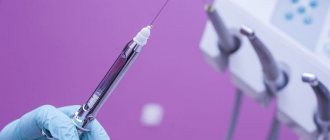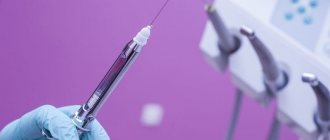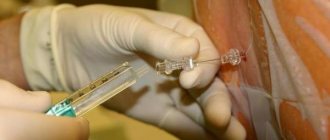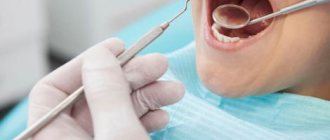Content:
- Methods used in dental practice
- Medicines that are most often used in the dental office
- What affects the duration of the anesthetic effect?
- What to do to quickly forget about dental intervention
- After what time can you eat?
Most people are afraid to have their teeth treated because they are afraid of pain.
It seems to them that any medical manipulation will cause them serious discomfort. Fortunately, the days of painful dental procedures are far behind us. Today, using highly effective anesthetics, doctors manage to make even the most complex procedures comfortable for the patient and completely painless. Meanwhile, some clients have a question about how long the anesthesia wears off after tooth extraction or pulpitis treatment. They are embarrassed by a long-lasting feeling of numbness. Let's consider this issue in more detail.
Infiltration anesthesia
Classic “freezing”, which is used in dentistry for almost any manipulation. The drug is injected under the mucosa, into the periosteum or directly into the bone. Depending on the procedure and the patient’s pain threshold, the required dosage is selected - for example, in case of acute pulpitis or complex tooth extraction, a higher concentration of the drug is used. If the patient is afraid of injections, topical anesthesia can additionally be used to numb the site of needle insertion, or xenon sedation.
When performing the procedure, the doctor must take into account the anatomy of the jaw system. For example, in the lower jaw the alveolar bone is denser, so anesthesia is less effective. In the upper jaw, when performing manipulations in the area of wisdom teeth, there is a risk of the needle touching one of the branches of the facial nerve, which is fraught with the development of neuralgia. The clinic’s doctors have the necessary qualifications, so even the most complex anesthesia is performed completely safely for the patient.
Methods used in dental practice
How long it takes for the anesthesia effect to disappear depends directly on the method of anesthesia used. The sensitivity of tissues is restored most quickly when using an application. The doctor applies a special gel to the area of upcoming manipulations, which “freezes” for about fifteen minutes.
If the anesthetic medication was administered using a syringe and needle, the area will remain numb for up to one to three hours. The exact time is determined by the location of the treated area, the dose and type of drug.
Types of anesthesia in dentistry
Anesthesia in dentistry can be general or local. The first includes intravenous sedation, as well as general anesthesia. That is, the drugs do not act locally in the oral cavity, but throughout the entire body. Actually, this is ordinary general anesthesia, which is used everywhere in medicine - it’s just that certain types are used in dentistry. Local, as it is already becoming clear, includes the familiar “freezing”, which is administered by injection.
Separately, we can also distinguish xenon sedation or xenon therapy - the second name will be even more correct, since such anesthesia is used to prepare for local or general anesthesia. It allows you to reduce the level of anxiety and stress, saturates the body's cells with oxygen, due to which it has a general healing and even rejuvenating effect! It is not an independent type of pain relief, but is used in combination with other approaches.
Medicines that are most often used in the dental office
If you need to numb a tooth, the doctor may use different drugs. The list of the most popular includes:
- Novocaine. Has a short period of action.
- Lidocaine and products containing articaine. Provides a medium-duration analgesic effect.
- Bupivacaine, Hirocaine, Ropivacaine. They have a long period of action.
The doctor determines which drug to choose taking into account the complexity of the upcoming treatment procedures. It is important that the patient is not allergic to the prescribed anesthetic.
Local anesthesia for treatment and extraction of teeth –
If previously novocaine and lidocaine were produced in the form of vials or ampoules, and injections with these drugs were performed using ordinary disposable 5.0 ml syringes, now all modern anesthetics are produced in the form of disposable carpules (cartridges). Each carpule usually contains 1.7 ml of anesthetic, and before anesthesia it is inserted into a special carpule syringe. Next, a very thin needle is screwed on (many times thinner than ordinary needles on disposable syringes), after which the syringe is ready for use.
What does an assembled carpule syringe look like?
Carpule of anesthetic and a special needle –
The cost of anesthetics and anesthesia - the cost of one anesthetic carpule for 2022 (be it ultracaine, ubistezin, septanest or others) - will be approximately 40-50 rubles. This is the price at which dental clinics purchase anesthetics. But the total cost of anesthesia for dental treatment in a dental clinic will be about 400-500 rubles per 1 carpule of anesthetic.
It is also worth noting that pain relief during the treatment and extraction of teeth in dentistry is included in the guarantee program of the health insurance fund. Therefore, anesthesia in public dental clinics should be provided free of charge, but only when using Lidocaine or Novocaine (imported anesthetic will be paid for). Next, we will talk about the types of anesthesia in dentistry.
What affects the duration of the anesthetic effect?
The same drug may work differently in different people. For example, for some the analgesic effect disappears in one hour, while for others it lasts two or even three hours. What affects the duration of anesthesia, besides the pharmacological characteristics of the drug itself? There are several fundamental factors:
- The presence of inflammation in the anesthetized area. For example, after the removal of a wisdom tooth that was painful, the rehabilitation period is always delayed. The fact is that the active compounds of anesthetics have an alkaline environment, and in a localized inflammatory focus it is acidic. The combination of the two media causes neutralization of the alkaline composition of the drug. Because of this, the pain relief effect either does not develop at all or disappears very quickly. With advanced inflammation, it is very important to correctly calculate the optimal amount of pain medication so that the patient does not feel acute pain during treatment.
- The inclusion of components in the administered drug that promote spasm of blood vessels. Such substances make the anesthetic more effective and increase the duration of its action.
- Patient's age. It is more difficult for older people to obtain pain relief, and the anesthetic effect lasts longer.
- The presence of diseases of internal organs. Metabolites of dental drugs are eliminated from the body due to the work of the kidneys and liver. If there are diseases of these organs, anesthesia lasts longer.
- Experience and accuracy of the dentist. When giving an injection, the doctor must follow the injection technique and accurately calculate the dose. Any mistake makes the result of using an anesthetic unpredictable.
What can I do to make the anesthesia wear off faster?
If the patient does not want the anesthesia to wear off for a long time and cause unnecessary discomfort, you can follow simple tips:
- When planning a trip to the dentist, you should exclude fatty foods and alcohol from your diet. This will help relieve the liver and other glands that produce secretions to speed up metabolism. Thus, the anesthetic will be removed from the body faster, and the frozen area will recover from anesthesia more quickly. It is worth limiting the intake of medications except for those that are necessarily prescribed by the doctor and the refusal of which can lead to negative consequences.
- After minor dental procedures, significant volumes of liquid and massage of the freezing zone will help relieve anesthesia.
- In case of complex operations, on the contrary, it is necessary to exclude impact on the place where the intervention took place. Eating food and liquids is possible no earlier than four to five hours later.
If the numbing, pain-relieving effect does not subside for quite some time after visiting the dental office, this may indicate that a nerve has been affected. In this case, you should consult a doctor for additional help and advice to avoid negative consequences.
Before going to an appointment, each patient at a dental clinic must be sure that there are no allergic reactions to anesthesia. Otherwise, before using anesthesia, the doctor must conduct testing by administering a small dose of the drug. This will allow you to get rid of possible problems and side effects after visiting the dentist.
Category: Tooth extraction Published by Mister stomatolog
What to do to quickly forget about dental intervention
Very often, upon returning home, the patient continues to feel numbness in part of the jaw. This condition can cause discomfort and even mild aching pain. In order for tissue sensitivity to be restored as quickly as possible, the following rules should be followed:
- On the eve of planned dental procedures, avoid drinking alcohol , fatty and heavy foods. If a specialist recommends taking any medications, it is important to follow his prescription.
- In the case of treating caries , removing tartar, grinding down the top layer of enamel under a crown, it is permissible to massage the gums. You can also drink warm tea or heated water. These simple methods will increase local blood circulation and create conditions for the speedy release of anesthesia. But, if anesthesia was administered before tooth extraction, there should be no talk of any self-massage - touching the hole with your hands is strictly prohibited. Otherwise, you can damage the blood clot that protects the wound from the penetration of bacteria and germs. This will lead to severe inflammation and bleeding.
Don't be alarmed if the anesthetic continues to work for up to six hours. The situation will normalize on its own. If the numbness does not go away longer, this is a reason to consult a dentist again.
What to do if the numbness does not go away?
There is no need to be afraid of prolonged tissue numbness; after a couple of hours, sensitivity will definitely return. If numbness in your teeth, tongue, jaw, or nose after anesthesia does not go away by the end of the day, you should call your doctor and report the situation. In rare cases, complications of anesthesia occur in the form of paresis and paresthesia - disruption of tissue innervation. They appear when a nerve is accidentally injured by a needle. In this case, you need to visit a doctor who will prescribe treatment for the pathology. When the anesthesia of the tooth wears off, discomfort and unpleasant sensations may appear.
In most cases, tissue anesthesia passes without a trace, so if there are indications for anesthesia, there is no need to be afraid to perform it. If you have had an unpleasant experience with pain relief or need emergency treatment under anesthesia, you should simply tell your dentist about it. The doctor will definitely take into account your wishes and will be able to control the amount of the drug and the duration of its action.
Which anesthetic is right for you - summary
- For bronchial asthma or high allergies, an anesthetic without preservatives is needed (usually sodium disulfite is used in anesthetics, which is needed to stabilize epinephrine or adrenaline). Therefore, the anesthetic “Ultracain D”, which does not contain any preservatives, is best suited for such patients.
- If you have thyroid disease or diabetes, in this case you also do not want to use anesthetics containing vasoconstrictor components - adrenaline, epinephrine. The drug of choice, for example, Ultracaine D, Scandonest or Mepivastezin. But, choosing between these three anesthetics, I would give preference to the first.
- If you have high blood pressure and heart disease - with moderate hypertension and compensated heart disease, the optimal choice is anesthetics containing a concentration of epinephrine (adrenaline) - 1:200000. This can be anesthetics “Ultracain DS” or “Ubistezin 1:200000”. In case of severe hypertension, decompensated heart disease, it is necessary to use anesthetics that are completely free of adrenaline and epinephrine. Then, for example, “Ultracain D” will do.
- If you are a healthy person - if you do not have the above diseases, then you can safely administer anesthetics containing epinephrine/adrenaline in a concentration of 1:100,000. Moreover, a person weighing about 70 kg can be given up to 7 carpules of anesthetic inclusive. An example of such anesthetics is Ultracain DS Forte, Ubistezin Forte and analogues.
→ The most powerful analgesics for toothache
Basic painkillers
Not any anesthesia can be used when extracting a tooth. In dentistry, only the most common and effective medications are used. And almost every hospital has Novocaine.
But in modern treatment, novocaine is used much less frequently. If previously not a single operation could be done without it, now this drug causes an allergic reaction in most people. It has a number of side effects:
- dizziness;
- lethargy;
- lowering blood pressure.
Today there are more intense anesthetics, and therefore novocaine is used only in combination. It is injected into the body with a small dose of adrenaline. In combination, these drugs have the best analgesic functions. But such a mixture should not be prescribed to people whose blood pressure is off the charts.
For infiltration anesthesia, a 0.5% lidocaine solution is used. This drug can be used for the conduction method; only a 1–2% solution is required. For an adult, the norm is 300–400 mg. Side effects of this medicine include:
- headache;
- fatigue;
- loss of sensation in the lips and tongue;
- heart rhythm is disturbed;
- blood pressure decreases;
- there may be hives.
The most modern anesthesia is a medicine based on the substance articaine. Such drugs can provide long-term and reliable pain relief. It is used by a large number of dental surgeons. The substance reaches its maximum effect after 10 minutes and maintains its result for 1–3.5 hours. But no matter how good the drug is, it always has side effects:
- muscle twitching;
- headache;
- tremor;
- nausea;
- vomiting reflex;
- diarrhea.
These are the most common side effects. But sometimes others happen:
- blood pressure decreases;
- cardiac arrhythmia is disturbed;
- rashes appear on the skin;
- angioedema may occur.
These painkillers cannot be used for meningitis, tumors, osteochondrosis, spondylitis, tuberculosis, metastatic lesions of the spine, heart failure, tumors in the abdominal area, severe arterial hypotension, and hemostasis disorders.
Use with caution during pregnancy. The drug may cause a decrease in the fetal heart rate.
A very good drug based on articaine is Ubistezin. It also contains adrenaline. It reduces blood vessels in the area where anesthesia was administered. This makes it difficult to absorb the substance. As a result, the analgesic effect begins to act within 3 minutes. In addition to the above listed side effects that drugs based on articaine have, Ubistezin also adds the likelihood of an ischemic zone in the area where anesthesia was administered. This occurs if a blood vessel has been hit or a nerve has been damaged.









